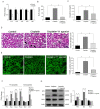Neuropeptide Y protects kidney against cisplatin-induced nephrotoxicity by regulating p53-dependent apoptosis pathway
- PMID: 26728272
- PMCID: PMC5070709
- DOI: 10.5483/bmbrep.2016.49.5.231
Neuropeptide Y protects kidney against cisplatin-induced nephrotoxicity by regulating p53-dependent apoptosis pathway
Abstract
Cisplatin is a platinum-based chemotherapeutic drug for treating various types of cancers. However, the use of cisplatin is limited by its negative effect on normal tissues, particularly nephrotoxicity. Various mechanisms such as DNA adduct formation, mitochondrial dysfunction, oxidative stress, and apoptosis are involved in the adverse effect induced by cisplatin treatment. Several studies have suggested that neuropeptide Y (NPY) is involved in neuroprotection as well as restoration of bone marrow dysfunction from chemotherapy induced nerve injury. However, the role of NPY in chemotherapy- induced nephrotoxicity has not been studied. Here, we show that NPY rescues renal dysfunction by reducing the expression of pro-apoptotic proteins in cisplatin induced nephrotoxicity through Y1 receptor, suggesting that NPY can protect kidney against cisplatin nephrotoxicity as a possible useful agent to prevent and treat cisplatin-induced nephrotoxicity. [BMB Reports 2016; 49(5): 288-292].
Figures



References
Publication types
MeSH terms
Substances
LinkOut - more resources
Full Text Sources
Other Literature Sources
Medical
Research Materials
Miscellaneous

